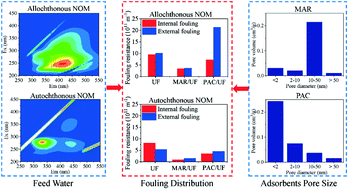Membrane fouling in an integrated adsorption–UF system: effects of NOM and adsorbent properties†
Abstract
The integration of adsorption with ultrafiltration (UF) is a promising technology for the production of high quality drinking water, but it is still under debate whether the addition of an adsorbent can mitigate membrane fouling. This study was conducted to investigate the impact of properties of the adsorbent and natural organic matter (NOM) in feed water on membrane fouling in an integrated adsorption–UF system. A continuous-flow hollow fiber UF set-up with periodic backwash and aeration was used to imitate the operation of full-scale integrated adsorption–UF systems. Two types of adsorbents, commercial powdered activated carbon (PAC) and homemade mesoporous adsorbent resin (MAR), were examined. As for Songhua River water dominated by allochthonous NOM, membrane fouling of the PAC/UF system was increased by 39.5% compared with that of UF alone, whereas the addition of MAR mitigated membrane fouling by 66.4%. For the synthetic water composed of algal organic matter (AOM), membrane fouling of PAC/UF and MAR/UF systems was reduced by 40.7% and 83.3%, respectively. The results suggested that deposition of adsorbent particles and fouling resistance of the cake layer were determined by the hydrophobicity and molecular weight distribution of NOM as well as the properties of adsorbents. This study highlights the significance of adsorbent selection for the integrated adsorption–UF process according to the source and properties of NOM.



 Please wait while we load your content...
Please wait while we load your content...